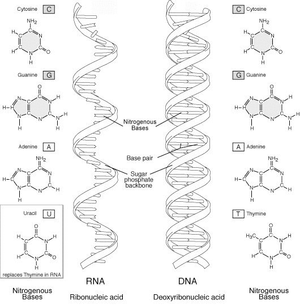RNA
|
|
Ribonucleic acid (RNA) is a nucleic acid consisting of a string of covalently-bound nucleotides. It is biochemically distinguished from DNA by the presence of an additional hydroxyl group, attached to each pentose ring; as well as by the use of uracil, instead of thymine. One of the main functions of RNA is to copy genetic information from DNA (via transcription) and then translate it into proteins (by translation).
| Contents |
Chemical structure

RNA has four different bases: adenine, guanine, cytosine, and uracil. The first three are the same as those found in DNA, but uracil replaces thymine as the base complementary to adenine. This may be because uracil is energetically less expensive to produce, although it easily degenerates into cytosine. Thus, uracil is appropriate for RNA, where quantity is important but lifespan is not, whereas thymine is appropriate for DNA.
Comparison to DNA
Structurally, RNA is indistinguishable from DNA except for the critical presence of a hydroxyl group attached to the pentose ring in the 2' position (DNA has a hydrogen atom rather than a hydroxyl group). This hydroxyl group makes RNA less stable than DNA because it makes hydrolysis of the phosphosugar backbone easier.
Synthesis
Synthesis of RNA is usually catalyzed by an enzyme, RNA polymerase, using DNA as a template. Initiation of synthesis begins with the binding of the enzyme to a promoter sequence in the DNA (usually found "upstream" of a gene). The DNA double helix is unwound by the helicase activity of the enzyme. The enzyme then progresses along the template strand in the 3' -> 5' direction, synthesizing a complementary RNA molecule. The DNA sequence also dictates where termination of RNA synthesis will occur.
RNA world hypothesis
The RNA world hypothesis proposes that the universal ancestor to all life relied on RNA both to carry genetic information like DNA and to catalyze biochemical reactions like an enzyme. In effect, RNA was, before the emergence of the first cell, the dominant, and probably the only, form of life. This hypothesis is inspired by the fact that retroviruses use RNA as their sole genetic material, and performed information-storing tasks. RNA can also act like a catalyst, a task mainly done by proteins today. There are several ribozyme's, catalytic RNAs, that have been discovered, and peptide bond formation in the ribosome is carried out by an RNA-derived ribozyme. From this perspective, retroviruses and ribozymes are remnants, or molecular fossils, left over from that RNA world. Assuming that DNA is better suited for storage of genetic information and proteins are better suited for the catalytic needs of cells, one would expect reduced use of RNA in cells, and greater use of DNA and proteins.
Biological role
RNA plays several roles in biology:
- Messenger RNA (mRNA) is transcribed directly (splicing in eukaryotes) from a gene's DNA (in eukaryotes exported into the cytoplasm) and is used to encode proteins.
- RNA genes are genes that encode functional RNA molecules; in contrast to mRNA, these RNA do not code for proteins. The best-known examples of RNA genes are transfer RNA (tRNA) and ribosomal RNA (rRNA). Both forms participate in the process of translation, but many others exist.
- RNA forms the genetic material (genomes) of some kinds of viruses.
- Double-stranded RNA (dsRNA) is used as the genetic material of some RNA viruses and is involved in some cellular processes, such as RNA interference.
- Transfer RNA (tRNA) is a small class of RNA molecules that present specific amino acids to the ribosome during translation, the anticodon of the tRNA pairs with the codon of the mRNA
Messenger RNA (mRNA)
Main article: Messenger RNA
Messenger RNA is RNA that carries information from DNA to the ribosome sites of protein synthesis in the cell. Once mRNA has been transcribed from DNA, it is exported from the nucleus into the cytoplasm (in eukaryotes mRNA is "processed" before being exported), where it is bound to ribosomes and translated into protein. After a certain amount of time the message degrades into its component nucleotides, usually with the assistance of RNases.
Non-coding RNA or "RNA genes"
Main article: Non-coding RNA
RNA genes (sometimes referred to as non-coding RNA or small RNA) are genes that encode RNA that is not translated into a protein. The most prominent examples of RNA genes are transfer RNA (tRNA) and ribosomal RNA (rRNA), both of which are involved in the process of translation. However, since the late 1990s, many new RNA genes have been found, and thus RNA genes may play a much more significant role than previously thought.
Double-stranded RNA
Double-stranded RNA (or dsRNA) is RNA with two complementary strands, similar to the DNA found in all "higher" cells. dsRNA forms the genetic material of some viruses. In eukaryotes, it may play a role in the process of RNA interference and in microRNAs.
See also
Template:Nucleic acidsbg:РНК ca:ARN da:RNA de:Ribonukleinsäure es:Ácido ribonucleico eo:RNA fr:Acide ribonucléique ko:RNA id:RNA is:RKS it:RNA la:Acidum ribonucleinicum nl:RNA no:RNA ja:リボ核酸 pl:Kwas rybonukleinowy ru:РНК fi:RNA sv:RNA tr:RNA zh:核糖核酸
